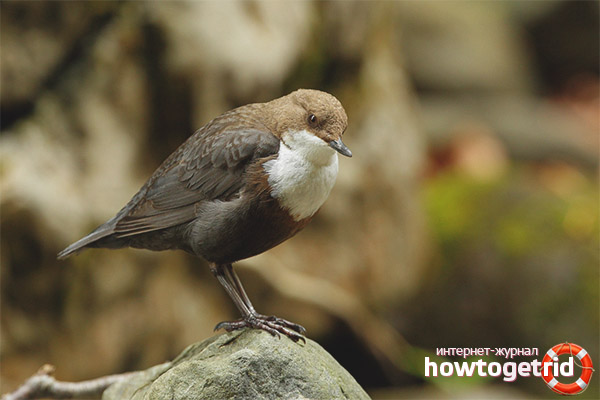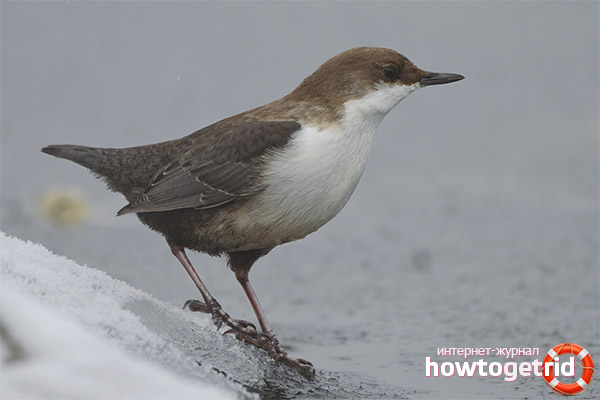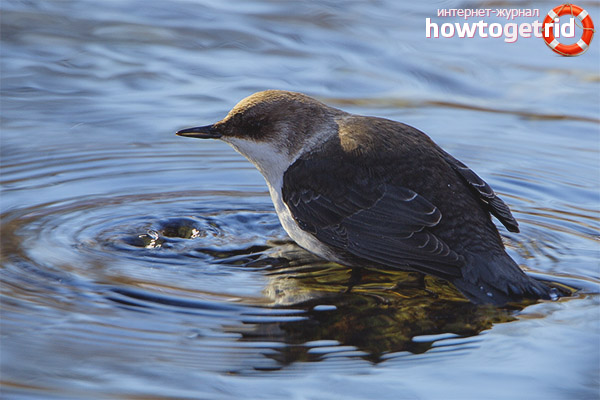The content of the article
Olyapka is a bird of the order Passeriformes, which stands out among its relatives by its characteristic appearance and a special passion for water. This small bird has a waterproof plumage, due to which birds of this species swim, dive and are able to even run along the bottom of shallow ponds, clinging tightly to the bottom with their paws with fairly sharp claws.
Often the dipper is called a water sparrow or a waterbird, which is explained by the similarity of the bird with this species of birds. The family of these birds includes only a few subspecies, but the most common among them was the common dipper. An interesting fact is that the dipper got the status of the official symbol of such a state as Norway.
According to experts, this bird got its name from such a derivative as "olyabysh", this word in Russia was usually called a small round cake. In accordance with another common version, the name of the bird is consonant with the designation of small round pebbles, which, when they fall into the water before jumping to the bottom, bounce several times along the surface of the water.
Appearance Features
Due to its unique appearance, as well as its constant presence in the vicinity of water bodies, the Olga is almost impossible to confuse with other species of birds. The common dipper has a fairly strong and dense physique, in size this species is similar to thrushes or starlings. The body length of adults reaches 20 cm, the maximum weight is about 85-90 grams. There are practically no external differences between females and males.
Representatives of the species have fairly long paws (4 fingers with sharp claws), so that they can easily move both on land and along the bottom of water bodies.
The wings of this bird have a slight rounding, the wing length is up to 105 mm. Span - up to 30 cm. The tail of the bird is quite short and slightly bent to the top.
Plumage of the species
The front part of the bird's body is decorated with a white elongated shirt front, perfectly and harmoniously contrasting with the main color of the feather cover. On the back of the dipper, when viewed close to you can see the original scaly pattern. The outfit of young individuals is several orders of magnitude lighter than that of adult representatives of the species.
The waterproofness of bird feathers is due to the fact that the bird has an extremely developed coccygeal gland, which secretes a rather greasy secret, which is sufficient for high-quality lubrication of the entire feather cover of the bird.
The voice of the bird
The dipper is considered to be a songbird, the sounds made by representatives of this species are a pleasant whistle and iridescent trills. Dippers sing almost all-season (the exception is nesting time).
Habitat
This type of bird can be found almost throughout Eurasia. The main condition for the dwelling colonies to live is the presence of nests with clean water and a fast current near the nesting territory (hilly landscape with sparse vegetation in the coastal zone).
In the period corresponding to the beginning of nesting, birds are usually divided into pairs, choosing a certain territory for life, to which they are very attached.
Note that these small birds spend most of their lives in or near the water; for the wintering season, they choose non-freezing sections of water bodies.
Power Features
As mentioned above, dippers prefer watercourses with a fairly strong current for their main habitat, ignoring streams and lakes with stagnant water and too dense vegetation. They swim very well in water, using their wings as oars. One of the features of this type of bird is that it has its own natural ballast, which implies the presence of brain matter in the bones of the bird, which, in fact, distinguishes the dipper from other bird species (in most species the bones are hollow). Due to the opening of the wings in the water, the dipper easily sinks to the bottom of the pond, whereby it can run several tens of meters.
The duration of being under water is about one minute. Under water, the nostrils of the bird are closed with special leathery membranes. Thanks to this, the bird can collect at the bottom the writing she needs for food. To rise to the surface of the dipper it is enough to press the wings to the hull, after which the water pushes the bird up.
As a rule, from the bottom, this small bird of the order of passerines collects for feeding eggs of small bottom fish, small insects, preys on crustaceans. The bird can also get its own food in the coastal thickets of vegetation, getting a variety of animals from under the pebbles inverted by tenacious claws.
Nesting Features

As mentioned above, the dipper is very attached to the territory of its habitat (biotope), therefore, even after seasonal migration, birds with the onset of heat always return to their favorite place for life. That is, instead of building a new nest, seasonal updating of the old is carried out.
The mating is mature at the age of one, after which the birds form pairs. In this case, representatives of the species occupy a certain, pre-selected part of the territory, the length of which is about 1.5 km. Particularly noteworthy is the fact that during the nesting period of the border of the site, the pairs are carefully guarded.
The construction of a new nest or the renewal of an old bird is carried out in early spring, the location of the nest near water bodies. The dipper’s nest can be located anywhere - both among the stones in the coastal zone, and on the branches of small trees or shrubs.
The most attractive places for placing bird's nests are the cavities of dry trees, as well as cracks or natural niches in the rocks.
Both females and males build a nest, for this purpose dry stems of various plants, rhizomes, and moss are used. It looks like a ball having the wrong geometry, dimensions - no more than a soccer ball. The entrance to the nest is tunnel-shaped, usually directed towards a nearby stream or some other reservoir with a fast current. Inside, the nest is often lined with last year's vegetation (dry stems, leaves).
Offspring
At one time, the dipper lays up to 7 eggs that are white in color without specks. Hatching is carried out exclusively by the female, while she is periodically excommunicated to obtain food for sustenance. The duration of incubation is about 14-18 days.
The first outfit of hatching chicks of this species is a downy, brownish shade, the pharynx is bright yellow or orange. Both parents are feeding offspring that have appeared.
Depending on weather conditions, young individuals of the dipper leave the nest after 3-4 weeks after birth. Although at this moment in life they are not yet able to rise into the air, nevertheless, they already swim quite well and dive. When danger arises, the chicks immediately throw themselves into the water, floating away and hiding in the coastal thickets.
Species population
According to environmental organizations, the population of such a species of bird as the dipper is quite large. Despite human intervention in the biotope of this species, the population size over the past decades has not decreased.
Although the dipper does not belong to synanthropic species of birds, nevertheless, the bird is often found in close proximity to human habitation, especially during the nesting season. In some areas of the Colony colony habitat, these birds are habitual inhabitants of the mountainous terrain (especially true for mountain resorts), where they become an excellent object for observation and photo hunting.
Video: Dipper (Cinclus cinclus)












Submit